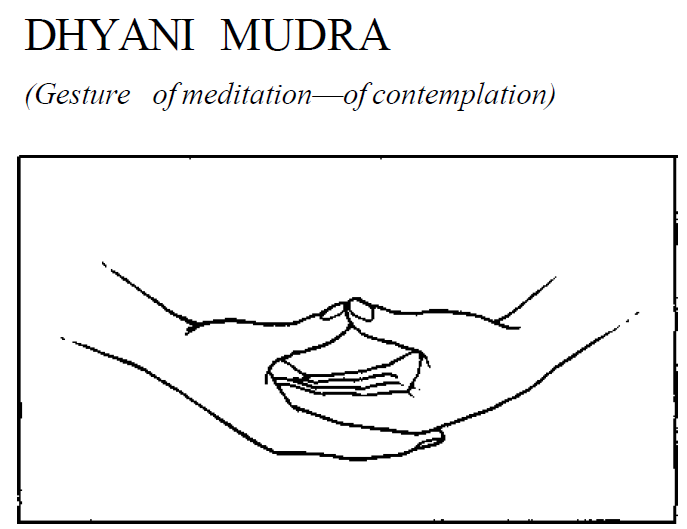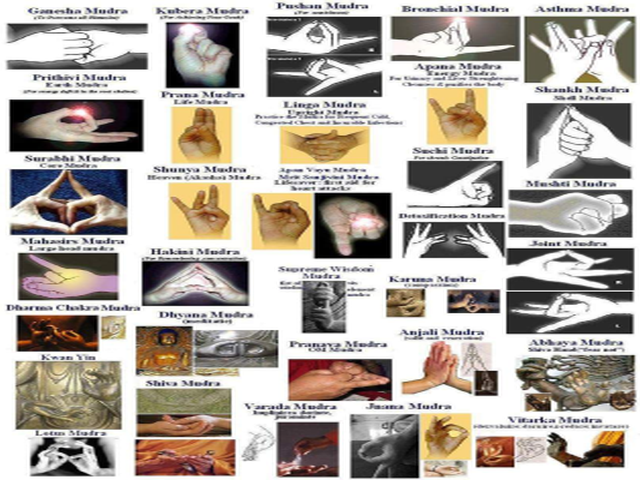Spiritual Mudras for Health

Acupressure points for Gallbladder
June 24, 2016
Mudra Exercises for Healing
June 24, 2016
DHYANI MUDRA (Gesture of meditation—of contemplation) 43
DHYANI MUDRA
(Gesture of meditation—of contemplation)Place both hands like bowls in your lap. The left hand lies in the right hand and the thumbs touch each
other.This is the classical meditation pose, and I assume it whenever I meditate without any special intentions. When I simply sit and observe my breath, I am completely passive and let the divine force act
within me and for me. I know that the Divine wants only the best for me and helps me at any time and place if I allow it. “Your will be done,” is an expression of most heartfelt joy.The two hands formed into a bowl show that we are inwardly free, pure, and empty in order to receive everything that we need on our spiritual path. Since there is no empty space in the universe (everything that appears “empty” to us is full of subtle energy), this void will become filled with new energy—our thoughts and feelings determine the quality. This is why it is so important to have done the work of forgiveness beforehand and live in peace with all beings.
It is also like a silent cooperation with your best friend. You no longer need to tell each other anything—you are content because you know that everything important has already been said. You feel the connection, and that is enough.
In classical meditation, emptiness is brought to mind with this mudra, meaning you think of nothing at all. This is very difficult; consenuently, there is also a second version. Here the attention is directed at
breathing—all the senses are focused on the breath. This is more likely to work, yet there may still be difficulties with it. If your thoughts stray too often from your breathing, or if you feel the smallest tendency toward negative brooding .
ATMANJALI MUDRA (Gesture of prayer) 42
ATMANJALI MUDRA
(Gesture of prayer)Place both hands together in front of your heart chakra. Leave a little hollow space between the two palms. At the beginning or close of the meditation, sit or stand for a while with your arms spread and raised to Heaven.
Placing your hands together in front of your chest supports inner collection and creates harmony, balance, repose, silence, and peace. This gesture activates and harmonizes coordination of the left and right brain hemispheres.
It can support a supplicatory meditation when you have a request of the Divine, when you have a heart’s desire that you would like to have fulfilled. With this gesture, you also express reverence or gratitude. In India, it is a gesture of greeting or thanks; it shows respect for fellow human beings.
EFFECTS:-
This mudra calms our thoughts and creates clarity as a result. Calming thoughts are always based on a certain power, power that builds up physical strength and stabilizes the mind, as well as clarifying and strengthening.

MUDRA OF THE INNER SELF 44
MUDRA OF THE INNER SELF
Place together the tips of your index middle, ring, and little fingers and the balls of your hands. Put the thumbs next to each other. Like a “street,” they lead to the fingertips of the little fingers which they touch. An empty space through which light shimmers, is formed beneath the tips of the little fingers.
This opening characterizes the power of the heart through divine wisdom. This opening is different for every human being.First hold your hands in this position in front of your forehead, and look through the opening, without blinking, as long as you can. Then lower your arms and hold the mudra an inch or so beneath your chin for a while. Your hands will automatically be at the spot where the place of the soul lies, according to the ancient mysteries, and they form a temple around it. Now pay attention to your breathing. With every exhalation, very gently whisper “Hoooo” and let yourself be carried through the little opening into infinity—into the great mystery.
When we hold this mudra while sitting in the meditation position with crossed legs, many triangles are formed with our body parts: beginning with the little space between the fingers; above the hands, arms, legs, and the entire body posture. The triangle is the symbol of the Divine, and our body now expresses this through its posture in a number of ways. This mudra is a prayer without words—a silent meditation, a devotion to the Divine.

LOTUS MUDRA (Symbol of purity) 45
45 LOTUS MUDRA (Symbol of purity)
Place both hands in front of your chest so that only the edges of your hands and pads of your fingers
touch each other: This is the bud of the lotus flower. Now open your hands, but maintain the contact
between the tips of the little fingers and the outer edges of your thumbs. Spread the other fingers open as wide as possible. After four deep breaths, close both hands back into a bud, place the fingernails of the fingers of both hands on top of each other; now join the backs of the fingers, the backs of the hands, and let your hands hang down relaxed for a while. In the same way, bring your hands back into the bud and the open flower. Repeat a number of times.This mudra belongs to the heart chakra and is the symbol for purity. Love lives in the heart, together with goodwill, affection, and communication. We are meant to keep it pure and give it unconditionally, like an open flower that holds its chalice open for the insects. It is their nourishment and gives them warmth on cold nights. In turn, the insects pollinate it and help it fulfill the purpose of its existence. We are connected with our fellow human beings in more or less the same way—in both the good sense and
the bad—and dependent upon them. However, the open flower has another message waiting for us. It opens to the sun, the divine principle, and lets itself be given whatever it needs; and it is given in abundance—it receives much more than it “needs.” We enjoy blossoming flowers because they bear joy, the divine countenance, within themselves, and exude it to us.Do this mudra when you feel drained, exploited, misunderstood, or lonely. Open yourself to the divine force and receive whatever you need— and much more.

VARADA MUDRA (Gesture of granting wishes or mercy) 47
47 VARADA MUDRA (Gesture of granting wishes or mercy)
Point the left hand downward and turn the palm to the front. Place the right hand on your lap or thigh.
This mudra is a preferred gesture in the depiction of Hindu gods. As the name indicates, this is a matter of forgiveness and mercy. Moreover, the believers hope that God will bless them richly—fulfill their wishes. This is aptly expressed. Someone who gives will be forgiven, someone who forgives will be richly blessed. Forgiveness always also means being able to forgive yourself. To forgive yourself and others is certainly the most difficult thing one can ask of a person. But it is truly the most wonderful thing when we succeed at it. The forgiving open hand is then filled with new riches, both inner and outer. I speak from experience here and can warmly recommend the “art of forgiveness” to you. Perhaps it may be difficult for you at first; if so, ask the divine force that lives within you for help.It is also important to know that the intensive work of forgiveness should not be done throughout the entire year—that would wear us down too much. But it fits wonderfully into a spring or autumn detoxification program.

BHUMISPARSHA MUDRA (Gesture of enlightenment) 48
48 BHUMISPARSHA MUDRA (Gesture of enlightenment, or gesture of calling witnesses)
Point the left hand down to the earth and let your fingers touch the ground. Let the right hand point
upward to Heaven, like an open flower.
DHARMACHAKRA MUDRA (Gesture of turning the wheel) 49
49 DHARMACHAKRA MUDRA (Gesture of turning the wheel)
Raise both hands in front of your chest with your right hand somewhat higher than the left. Join the thumbs and index fingers of each hand. The palm of your left hand faces your heart, and the back of your right hand faces your body. The left middle finger touches the place where the thumb and index finger of
the right hand form a closed circle.Before you continue to read, pause for a moment and try the Dharmachakra Mudra. While forming it, breathe very deeply, slowly, and finely; focus on how the three fingertips are touching each other. How do you feel? It is possible for you to notice a change in your mood or not?
The hands form two wheels. In Hindu mythology, the wheel embodies completion or the wheel of life that guides us through a diversity of experiences. But there are two wheels here, and this indicates the teaching of reincarnation. The left middle finger (Saturn) represents the transition from this world into the next—from death and birth.

VAJRAPRADAMA MUDRA (Gesture of unshakable trust) 50
50 VAJRAPRADAMA MUDRA (Gesture of unshakable trust)
Cross the fingers of both hands in front of your chest. Solid fundamental trust is the basis for healthy self confidence. We experience times when we think we can deal with whatever comes our way; and there are times when we doubt ourselves, we feel insecure and think ourselves not capable of handling anything that happens. When we take a closer look at things, we notice how important inner strength is
for our self-confidence. When we are weakened, no matter on what level (physical, mental, emotional), then insecurity sneaks in. We can build up our inner strength with specific mudras, physical exercises, and breathing exercises.
NAGA MUDRA (symbolizes supernatural strength) 51
51 NAGA MUDRA (Naga, the snake goddess, symbolizes supernatural strength, wisdom
shrewdness, and potency)Cross your hands in front of your chest, and also cross your thumbs over each other. This gesture is
sometimes called “the mudra of deeper insight.” Even when we take the spiritual path, we will encounter
worldly challenges time and time again. Only by working through these challenges do we progress on
the path; and only so can we fulfill the purpose of our lives. This is why the Naga Mudra can be successfully used to solve everyday problems. Answers can also be expected to questions about decisions that must be made, the meaning of a specific matter, the future, and the spiritual path. When we need to know something, then we will also know it at the right time. But we must question and listen.Blazing fire is a powerful element. It warms, moves, and activates us. This is why visualizations of fire always set something in motion, develop strength, and pleasantly relieve tensions. When we mentally kindle the fire in our pelvic floor, this will not only give us strength, but also light. We can carry this light with us like a torch, and it will show us the way.

PUSHPAPUTA MUDRA (A handful of flowers) 52
52 PUSHPAPUTA MUDRA (A handful of flowers)
Place your hands like empty bowls on your thighs. Let your fingers rest next to each other in a relaxed way, with the thumbs against the outer edge of the index finger. The focus here is openness and acceptance. What wealth does life (or the universe) have waiting for us? How often do we pass it by without paying any attention? How often are we outwardly or inwardly closed to a new opportunity?
How often do we ignore the gentle hints from the universe until we need the blows of fate to get back on the right track? We can be spared all this if we remain open. One reason why we close ourselves—in addition to apathy—is fear. But whatever is bad cannot get to us and affect us if we strive for a pure heart. This is a law of the cosmos. We can only attract what also has an equivalent within us. This is why mental-emotional hygiene is so important. We can hardly avoid the negative feelings that occasionally arise within us, but we can also come to terms with them and transform them at any time. This is part of the maturation process.
The Pushpaputa Mudra expresses this openness. Only with open hands can we enrich the world, and only with an open mind and open soul can we receive what cosmic consciousness gives us.

ABHAYA MUDRA (Gesture for promising protection) 46
46 ABHAYA MUDRA
(Gesture for promising protection)Raise your right hand to chest level with the palm facing forward. Place your left hand on your left thigh, in your lap, or on your heart. We see this gesture in many depictions of deities. It promises the believer protection and freedom from fear. It also shows the strength of the respective deity.
We must remember that fear or fright are basically signs of weakness. The Chinese Five Element Theory
shows that, among other things, a weakness in the fire element creates a fear of others, in the wood element it creates a fear of being defined through others; in the metal element it creates a fear of too little or too much distance (loneliness); in the earth and water elements it creates a fear of challenges and life in general. Fear has infinitely many faces, but its cause is always weakness. The greatest commandment of the yogis is nonviolence. The stronger a person is, which also includes strength on the
mental-emotional level, the more he or she will be able to live nonviolence, since a strong person is rarely attacked. Many people are weakened as a result of inner conflicts, because of a certain lack of unity within themselves. These inner battles are then carried out in the outside world by attracting the appropriate battle partner. We must keep all of this in mind when we seek refuge in this mudra.
The following mudras have been used in temples and churches since time immemorial to support meditation or prayer. They can always be seen in the Hindu depictions of the gods, as well as in portrayals of Christ, Buddha, and the saints. The hand position of the respective deities or sages expresses an inner state of mind as well; the meditating person hopes, either consciously or unconsciously, to also enter into the appropriate mood. The mudras symbolize characteristics that we hope to acquire. After long meditative observation, people can take on these characteristics. Another example of this principle is that after looking at the many sculptures of the gods, visitors to museums in Greece assume a more upright posture themselves.
I believe that spirituality should be integrated into everyday life, plans for the future, and coming to terms with the past. Consequently, I have also included in this chapter newer mudras that address the habits of thought and feeling.
There is usually no indication of how long the mudras should be done here since this is different for each individual. One person may need to do the following mudra meditations just once, and for only a few minutes to feel their effects—depending on the level of inner maturity; other people may have to meditate for several days or even weeks, from 7 to 30 minutes a day, before they even perceive that something has changed or that their connection with higher consciousness has deepened.















